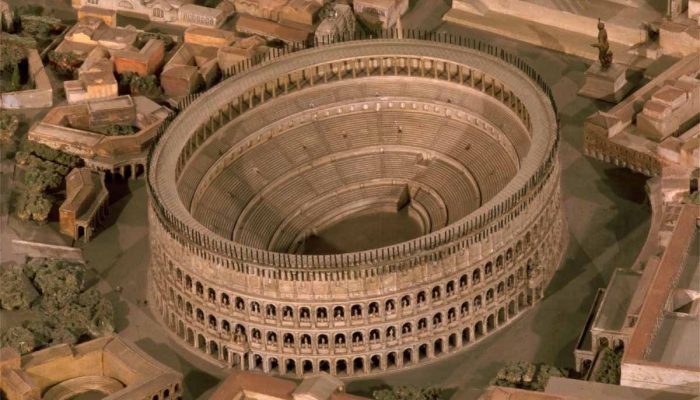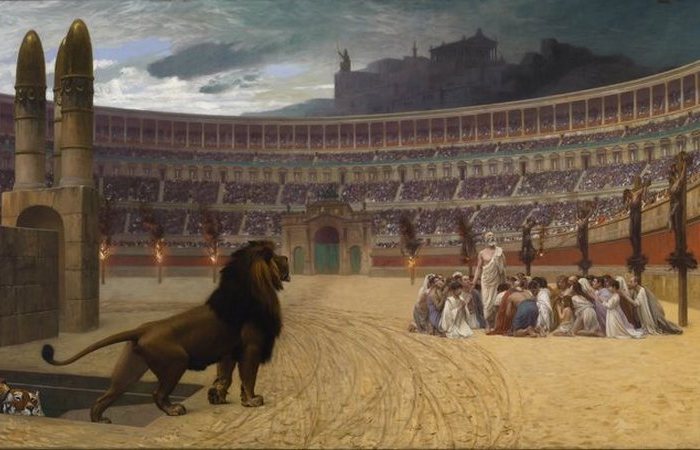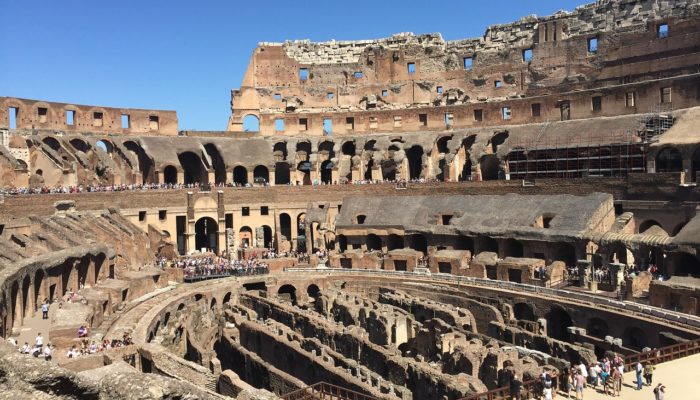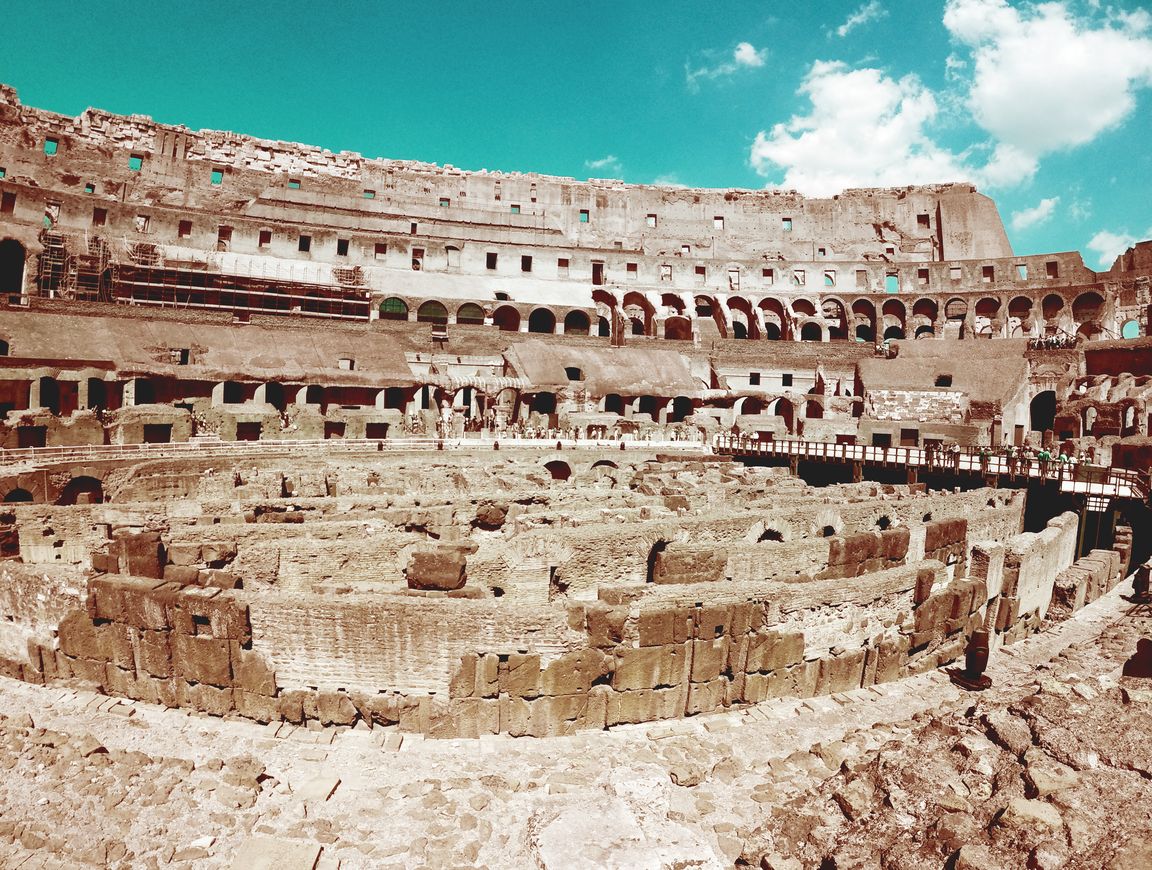One of the most attractive and stunning places of tourist Rome is the ancient Colosseum, built on the site of a lake where swans once swam…
This is the second most popular (after the Vatican) and the first most visited historical monument in Rome.
The Flavian Amphitheater - this name comes from the dynasty of emperors: Vespasian Flavius, who began construction (in 72 AD), and his son Titus, who completed this grandiose structure (in 80 AD). The subsequent name “Colosseum” (from the Latin word colosseum (colossal), it received from the name of the 35-meter bronze statue of the Ear of Nero, installed near the amphitheater.

Photo: awesomeworld.ru
The Colosseum can be called a double amphitheater, it consists of two half rings connected in the form of an oval. The unprecedented dimensions of the Roman amphitheater are striking: in the axes - about 156 x188m, height – 48,5 m.
The complex consists of four floors: the first three - repeating columns and arches, made in Doric, Ionic, Corinthian styles, with sculptures of Roman soldiers and gods; the fourth floor is a blank wall without windows.
The surface of the arena was sprinkled with sand, the seats of the stands were carved from marble, concrete, local tuff and brick were also used. A special canopy made of long strips of fabric (velarium) was installed on the walls of the amphitheater in the form of masts, intended as a salvation from the heat.
The entrances to the Colosseum (about 80) led to a certain tier: the lower one was for aristocrats, the middle one was for noble warriors, and the upper one was for commoners. Through them, viewers could completely fill the building in a quarter of an hour, and leave within five minutes. The amphitheater could accommodate only 50 000 visitors.
An interesting innovation used by the Romans during the construction was an ingenious lifting device, a crane, for lifting heavy materials onto the upper scaffolding.
More than 100 thousand slaves were specially brought to Rome from Judea, and professional architects, builders, engineers, sculptors were invited to erect a pompous and majestic giant building.
The main purpose in the history of the construction of the Colosseum is entertainment events for the rich Roman nobility and thousands of spectators in the form of animal baiting and gladiator fights.

Photo: rome24.ru
The selection of fighters among whom they fought: volunteers, former military men, criminals and slaves, was held very carefully, taking into account weight, height, combat experience, skills, fighting style. Battles were fought to the death (hence the second name of the Colosseum - the temple of death), or after which, the career of gladiators ended with retirement, with a lifetime cash payment.
In fights with animals participated: lions, elephants, tigers, bears and hippos. According to historians, about 400 000 people and more than 1 million animals died in the arena of the Colosseum during the entire period of the gladiatorial games.

Photo: kulturologia.ru
What secrets do the dungeons of the amphitheater keep? This is almost a labyrinth under the arena, consisting of service rooms, rooms for keeping people and wild animals, lifting mechanisms with which they got into the arena in cages and on platforms.
The German archaeologist Heinz-Jürgen Beste drew up a detailed plan of the premises and conducted parallel studies of the mechanics of ancient Rome in order to understand what devices were used in the Colosseum.
For ship games and naval battles, the arena of the amphitheater was flooded by 1 meter (water was supplied through special aqueducts) to install reconstructions of warships.
The history of the decline of the Colosseum began with the rise of Christianity, as the Romans, who adopted the new faith, could not continue to enjoy bloody battles, and in 523 AD. after popular protests, the Roman authorities also banned the killing of predators.

Photo: awesomeworld.ru
After the earthquake of 847, the Roman nobility and priests began to plunder marble for the construction of churches and famous buildings, for example: for St. Peter's Basilica, Palazzo Venezia.
The well-known billionaire Biego Della Valle plans to donate 33 million USD for the restoration of the Colosseum (it began in 2013).
The symbol of Italy, about which the locals say: “as long as the Colosseum stands, Rome will stand”, is experiencing its new revival today ...

Interesting facts:
- the elliptical shape of the arena did not give either gladiators or doomed animals a chance to hide from bloodshed;
- an original special effect - the sudden appearance of animals and gladiators in the arena was due to 28 elevators that instantly lifted them out of the dungeon;
- “Bread and circuses!” - this is how the motto of the grandiose amphitheater sounded for centuries, people were waiting for deadly entertainment;
- the first officially recorded protest against the brutal performances in the arena dates back to 404 AD, when the monk Telemachus jumped up screaming from his seat in the podium, demanding that the fight be cancelled. Furious spectators stoned him to death;
- tourists often visited the amphitheater at night to admire the beautiful illumination of the building, but now it is only open for daytime visits;
- there are two days off in a year when tourists cannot visit the Colosseum - December 25 and January 1;
Resources: undergroundexpert.info; diletant.media/articles; shkolazhizni.ru; AwesomeWorld.ru; wikiway.com.
Also read:
- Museo Subacuatico de Arte in Mexico: secrets and myths of the underwater museum
- The British Museum – great monuments of the world
- Tsar's toys - an unusual collection of Peter I in the Kunstkamera
- Vatican Museums: interesting facts, rare exhibits and the Sistine Chapel
- The Metropolitan Museum of Art: over 5000 years of world art history

